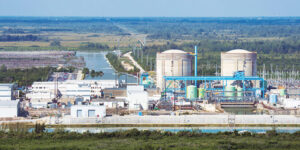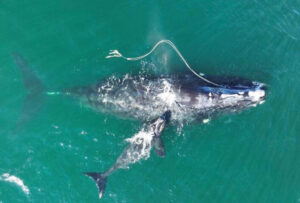STAFF & WIRE REPORTS
At the edge of Biscayne Bay, Turkey Point’s two nuclear units provide power to millions of people.
The facility, which came online in the early 1970s, is operated by Florida Power & Light (FP&L).
Situated within 25 miles of downtown Miami and Key Largo, the plant also sits atop the Biscayne Aquifer, the sole source of drinking water for over four million people in South Florida.
With the difficulty and high cost of constructing new nuclear plants, many power companies are instead seeking to run existing plants for decades longer than planned. Most of the nation’s aging nuclear plants are being tested in ways that were not initially expected — and they are now facing climate risks not considered in their original designs.
Because nuclear power plants need vast amounts of water for cooling hot reactor cores, they typically are located near coasts or rivers. However, this places the utility at risk from climate change impacts, including tidal and storm surge as well as flooding. Furthermore, decommissioning nuclear plants can take up to 60 years; this extended time-horizon puts them at even further risk from decades more exposure to climate change and sea level rise.
The plant at Turkey Point is cooled by a radiator-like network of cooling canals carved into the porous limestone substrate that also contains the freshwater drinking aquifer serving Miami-Dade County and the Florida Keys.
As the heated water circulates through the cooling canals, it partially evaporates, and concentrated saltwater seeps through the porous limestone down into the aquifer.
A large, hypersaline plume now emanates from the cooling canals and through the subsurface aquifer, forming a deep plume below the wetlands surrounding the property. Florida Power and Light has made efforts to retract the plume via a recovery well system with partial success, though some areas of the plume are expanding in the lower layers of the aquifer.
Additionally, Turkey Point lies within “hurricane alley,” the band of warm water that stretches from the west coast of Africa to the southeastern United States. Perched at the edge of Biscayne Bay and between two national parks — Biscayne National Park and Everglades National Park — the property, which was once part of the historic Everglades, is susceptible to catastrophic wind and storm surge events that are exacerbated by sea level rise and increasing storm intensity.
A recent NPR analysis showed that storm surge is a particularly urgent threat for the low-lying southern end of Miami-Dade County, where the Turkey Point nuclear power plant is located (Staletovich et al., 2022).
Although the plant’s reactors are elevated about 26 feet above sea level, the surrounding area (roads, the cooling canal system, backup power, and other infrastructure) is not. Climate models reveal “highly likely” regular flooding of the area around the plant by the 2040s — even under best-case scenario conditions (USACE, 2013). If the cooling canal system is flooded, plant operations could contaminate Biscayne Bay.
In 2018, FP&L made the first-ever request to run a nuclear plant, Turkey Point, for a total of 80 years, into the 2050s (NRC, 2018). FP&L asked the Nuclear Regulatory Commission (NRC) for a 20-year license extension to run the plant past its current expiration date (2032) to 2052.
Despite the risks of groundwater contamination and climate change, the NRC granted the 20-year license extension using existing environmental reviews that did not analyze environmental impacts over the full 80-year time horizon.
Nor did these reviews (a generic and a supplemental environmental impact statement) address how rising seas would impact the plant, or how documented groundwater pollution emanating from the cooling canal systems would affect the local environs.
With high stakes for the future of the nation’s aging nuclear plants, Miami Waterkeeper and their partners at the National Resources Defense Council and Friends of the Earth filed a legal challenge against this unprecedented license extension application in August of 2018.
Despite their contentions, the NRC granted the license extension to FP&L — a decision that the groups appealed (NRC, 2019).
After more than a year of waiting on the appeal to be decided, Miami Waterkeeper and their partners prevailed. In an astonishing first, the NRC announced in February 2022 that they were limiting the expiration date of the new license back to the previous expiration date of 2032. They also concluded that additional environmental review would be necessary for extending the license of Turkey Point and for other nuclear plants across the country.
On March 3, 2023, The NRC published a 60-day comment period in the Federal Register to solicit comments on the agency’s “Generic Environmental Impact Statement (GEIS) for License Renewal of Nuclear Plants” (LR GEIS).
This comment period offers another chance to improve the environmental review process that informs these new rounds of license extensions to run power plants across the nation for the coming decades.
The newly published draft LR GEIS will require all nuclear power plant operators applying for a license extension to address climate change and groundwater quality degradation impacts on a site-specific basis. Impacts on national marine sanctuaries must also be evaluated on a site-specific basis in the license renewal process. Comments are due May 5, 2023.●
This article is courtesy of the Miami Waterkeeper.
















































